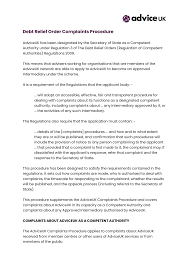Debt Relief Order – What You Need to Know

Using a Debt Relief Order is a good way to stop creditors from taking you to court. This is a legal solution designed to help people with low assets who are having trouble paying back their debts. It can be effective at relieving stress and improving your financial situation. However, there are some restrictions.
First, a Debt Relief Order can only be applied for by a specialised debt expert. This individual is called an authorised intermediary. They will then submit the application to the Official Receiver, who is an employee of the bankruptcy court. The receiver will then contact your creditors to tell them that you have applied for a DRO. They can object on certain grounds, but they cannot block the application on the grounds of ineligibility. If your application is rejected, the Official Receiver will explain the reasons for it.
You must also disclose your total debt amount before applying. If the total is more than PS30,000, you can be rejected for a DRO. You can also be denied a DRO if your credit rating is lower than PS500. You may have to re-apply after you improve your financial circumstances. If you break the DRO, you will have to pay fines and can be sent to prison.
The restrictions in a Debt Relief Order are similar to those in a bankruptcy. They limit you from acting as company director, and you can’t get credit over PS500 without disclosing your DRO status. Taking out credit after you have declared your DRO can be dangerous, and it can affect your ability to get a mortgage or contract-based products. The restrictions can be extended for a further 15 years if you don’t comply. You can also be prevented from taking out a new rental agreement.
A Debt Relief Order can be an affordable and effective way to clear your debts, but there are some limitations. It can make it harder to get a mortgage, as you will not meet lenders’ affordability criteria. It can also hinder your ability to get contract-based products and can have a negative impact on your credit rating.
You should not apply for a DRO if you are currently in a formal insolvency procedure, such as a personal insolvency petition or an IVA. The Insolvency Service can also provide you with information on your next steps. They will ask you about your income, living expenses, and debts. If you are eligible for a DRO, the Insolvency Service will process your application within 10 working days. The length of the DRO process depends on how fast you can provide your information.
You will have to pay a fee to the Official Receiver before submitting your application. This fee is non-refundable. You must also inform the Official Receiver of any changes to your financial circumstances. The Official Receiver will then consider the facts of your case, and if they feel you are eligible, they will issue you a Debt Relief Order.
Debt Relief Order – What You Need to Know was first seen on Apply for an IVA
